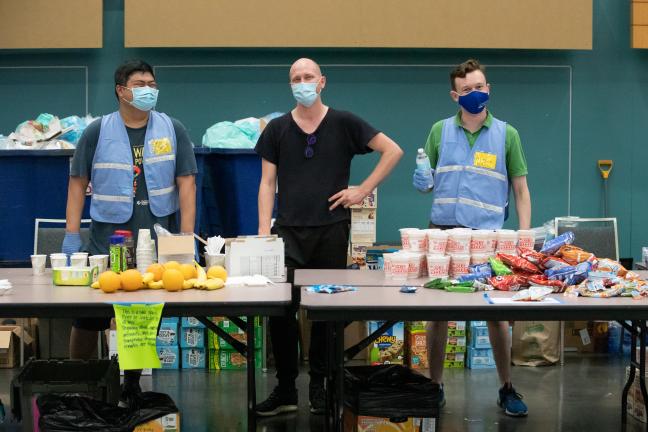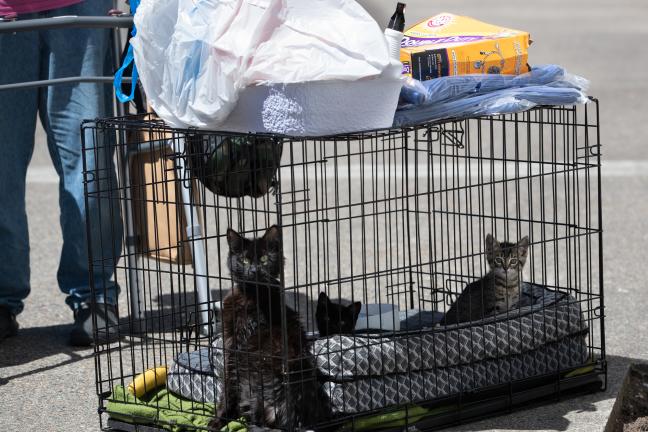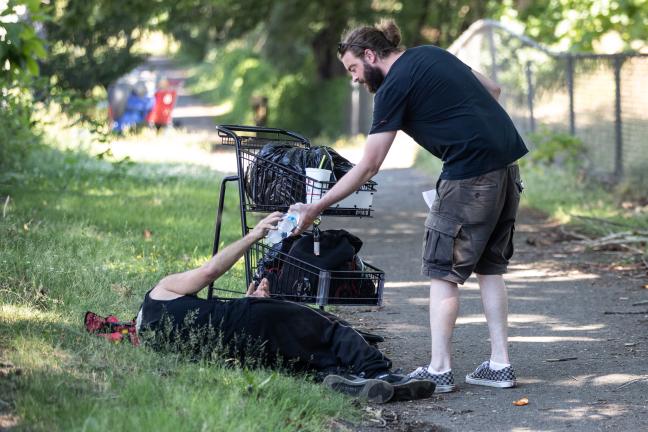Two months after an unprecedented “heat dome” shattered temperature records across the region, Multnomah County emergency management and health and human services experts delivered preliminary findings and action steps to the Board of County Commissioners on Thursday, Aug. 26. The report provides a basic timeline of events, chronicles interventions and identifies lessons learned to better prepare for future heat waves.
For three straight days in June, the Pacific Northwest was “basically trapped inside an oven,” said Health Officer Dr. Jennifer Vines. From June 26 through June 28, Portland recorded never-before-seen temperatures on consecutive days, registering at 108, 112, and finally 116 degrees. Very high overnight lows provided little relief, driving heat-related illness, hospital visits and deaths.
In response to the heat wave, Multnomah County immediately implemented a three-pronged strategy, which included: communicating the risk that extreme heat posed to the community; providing access to physical spaces for people to cool down; and conducting extensive outreach to vulnerable groups, including older adults, people with disabilities, and people experiencing homelessness.
Still, as of Aug. 26, Multnomah County has registered 62 heat-related deaths from the June extreme heat event. Other jurisdictions in the region also reported numerous heat-related deaths, with 30 deaths in King County, Washington, and more than 400 in British Columbia, Canada. The majority of deaths in Multnomah County were older, white adults who lacked central air conditioning. Many lived alone or experienced isolation.
“These lessons we learned and the ones we’ll follow in the fuller report are going to be indispensable for the way the County shows up in these bouts of heat from here on out,” Chair Deborah Kafoury said. “Even as our County pushes itself to the limit to help our community endure the many harmful impacts of the pandemic, we are still seeking ways to improve in every area that affects the people we serve, and especially those who are most vulnerable.”
Multnomah County opens cooling centers, spaces
Multnomah County opened three 24/7 cooling centers on Friday, June 25, at the Oregon Convention Center, the Arbor Lodge Shelter in North Portland and the Sunrise Center in east Portland. Within hours, dozens of guests began accessing the spaces.
Over the course of the heat wave, the three cooling centers served more than 1,400 overnight guests and provided guests with more than 6,500 meals.
Partners including TriMet, 211info, and Aging and Disability Resource Connection provided transportation assistance. Multnomah County also opened multiple library locations to give people a place to cool down during the day.
As the heat event continued to unfold, the County expanded operations to meet the needs of the community. As more people used cooling resources, the County expanded into additional spaces at the Oregon Convention Center and brought in more staff and resources.
“It wasn’t uncommon for us to see 50 people during a heat event [in previous years], and we had, I think, over 60 people on the first day at just one of our locations,” said Emergency Manager Chris Voss. “It wasn’t a static event. And I’m very, very happy we did not turn anybody away.”
A multi-pronged, multilingual communications strategy
Multnomah County’s Help For When It’s Hot webpage served as an information hub throughout the event. The webpage contained information about cooling center locations, the risks of extreme heat, and strategies to stay cool. It also contained downloadable fact sheets and resources for partners and providers.
In total, the County produced 27 heat-related graphics and warnings directed at multiple audiences including seniors, young people, athletes, and people working outside. Many of those were translated into languages other than English.
The County also created seven heat warning videos and posted more than 130 safety messages across multiple social media platforms and wrote seven media releases and stories. Experts including Dr. Vines served as the public-facing expert for local and national media.
Media interest from local, national and international outlets was unparalleled due to the historic nature of the event.
“The result was more than 150 media stories, most of them on the hottest three days of the event,” said Julie Sullivan-Springhetti, who directs communications for the County. “We were in a position of needing to meet this demand and have guests at the cooling centers and the libraries and our staff and volunteers to feel safe and respected.”
Since June, the County has worked with the City of Portland to expand the ways it reaches people who are potentially isolated using the public alert system to warn of the dangers of extreme heat. On July 28 and Aug. 11, the County worked with Portland Bureau of Emergency Management to send messages to all landlines and some cell phones.
On Aug. 13, for the first time ever, the County and City sent a Wireless Emergency Alert or special text to every cell phone in English and Spanish. The text boosted traffic to the Help for When It’s Hot webpage from 945 views to nearly 22,000, and viewers spent twice as long as usual on the site.
Sullivan-Springhetti said the County also improved the communication structure among partnering agencies, and established protocols for the release of information regarding hyperthermia deaths.
The County is also committed to launching seasonal awareness messaging communicating the risks of extreme heat and training more County staff to serve as public information officers to expand the pool of emergency communicators.
Community-based organizations, volunteers help County provide outreach to vulnerable populations
The County understood the impact of extreme heat on vulnerable populations and immediately began reaching out to those most at risk.
Together with its partners, Multnomah County reached out to 3,850 high-risk older adults and people with disabilities in 650 care homes. County staff also reached out to 12,000 pregnant County clients via text and contacted property management companies and apartment owners, advising them to expand cooling resources and perform wellness checks on their residents.
Sixty-nine community-based organizations and dozens of volunteers checked in on residents experiencing homelessness, said Marc Jolin, director of the Joint Office of Homeless Services. A County-operated supply center served as a hub for survival gear like water and personal protective equipment, all of which volunteers and mutual aid groups were able to access. Together, they distributed tens of thousands of water bottles, and hundreds of cooling kits, misters and towels across 30 distinct geographic locations across Multnomah County.
Behavioral health experts and service providers also engaged in person with unsheltered residents, making sure they were aware of resources available to them. Outreach workers helped make sure people living outside had access to a cooling center if they wanted it. If they chose to remain in place, they received critical supplies to help them stay hydrated and cooler.
“It was definitely a surge of community commitments to meet the needs of folks who were unsheltered during that heat event,” said Jolin. “There were hundreds of folks who did it, to take care of those who were unsheltered.”
Lessons from June already in place in August heat wave
Immediately following the June heat wave, the County held multiple after-action meetings to debrief with incident responders on what worked and what didn’t. Normally, the County takes months to formally debrief after a large emergency. But with more extreme heat expected during the summer, Chair Kafoury directed Emergency Management and department leaders to expedite the assessment. Emergency management leaders quickly got to work to identify what worked, what didn’t and ways to improve the County’s response to future heat events.
Thanks to their urgent work, Multnomah County was prepared to implement new response measures during two subsequent heat waves.
The most recent of those heat waves occurred Aug. 11 to 14. Using lessons learned from the June event, the County and the City of Portland initiated a unified command response. By formally coordinating their responses, the County and the City were able to make swift decisions in unison.
The County and the City opened four 24-hour cooling centers, one daytime cooling center, and six misting stations. Multnomah County Library also opened additional sites for people to visit during the day. Partners including 211info and TriMet ensured anyone who needed transportation to a cool space had access to it.
Beyond that, the County also implemented more robust outreach and maintained its supply distribution work to support people experiencing homelessness. Staff also made hundreds of phone calls to vulnerable residents and made door-to-door wellness checks to at-risk residents, including those who live in mobile home parks and areas more prone to extreme heat.
“The work we have done in getting communications out to people, and the wireless emergency response, also saved lives,” Commissioner Jessica Vega Pederson said. “I was so glad to see that step had been taken.”
Heat emergencies expected to become more frequent
The June heat wave would have been virtually impossible without human-caused warming, said John Wasiutynski, who directs the County’s sustainability work. A group of climate scientists recently found that this type of event would previously have been a once-in-a-thousand-years scenario.
With unchecked carbon dioxide and fossil fuel emissions, Wasiutynski said, the County must be prepared to respond to these events more often.
“We can expect this more frequently, with obvious consequences to human health and the health of our ecosystems,” Wasiutynski said. “The root cause of the climate crisis and global heating is the unprecedented release of carbon dioxide from the consumption of fossil fuels.”
In response to the climate crisis, Wasiutynski said, it’s important to prepare communities now for the impacts that are coming. He added that it’s also critical to reduce emissions significantly. The County is a leader in sustainability and frequently takes steps to protect the climate, from reducing carbon emissions to taking a stand on climate change.
On Tuesday, Aug. 24, the Board of Commissioners issued a statement opposing Zenith Energy’s application to expand its oil terminal, arguing that the impacts of new fossil fuel infrastructure, along with the terminal’s location along the Willamette River, pose a grave environmental health hazard for the entire community.
“We made it really clear that this is a crisis and that we actively oppose anything that is going to contribute to deaths and catastrophic events,” Commissioner Lori Stegmann said.
The County has also mapped areas of the community that are hotter due to less green space, gathering data that will help make targeted interventions aimed at reducing sun absorption. And, because of the passage of House Bill 2021, the County is working with utility providers to accelerate the decarbonization of the County’s electrical supply.
“We know this isn’t going to be a once-in-a-thousand-years event,” Commissioner Vega Pederson said. “This is going to happen more frequently. We understand we
have to take this as seriously as possible, looking out for neighbors.”
The final After Action Report will be completed by December 2021.



